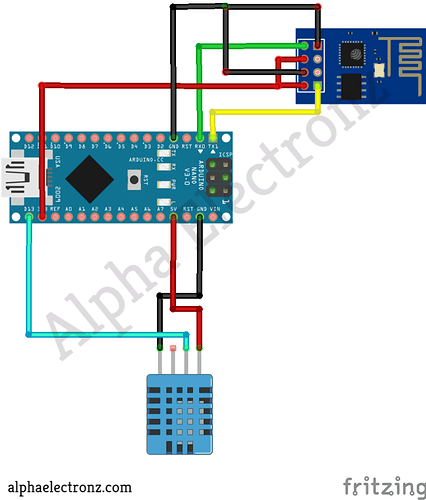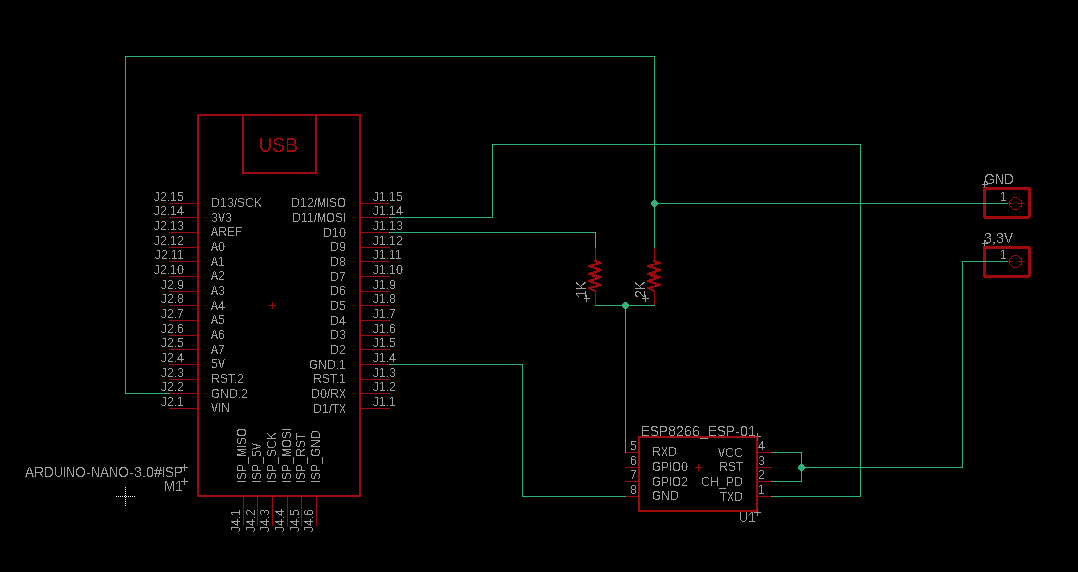Hello again guys,
I’am working on a project about on esp01 (based on esp8266) I just want to connect it to the blynk app for the time being. basically the connection is simple it is just esp01 module connected to arduino nano and I used the esp as a wifi transmitter reciever.
When i tried to run it using the code below I got the ESP not responding. I tried several wiring even using an external breadboard power supply (input from 12V adapter) but still not responding.
The problem I think is not from the ESP01 itself, because every time I tried a wiring I do AT command to check if the module is ok and these are the test that I do.
AT
OK
AT+CWLAP
+CWLAP:(0,"Elevenian",-55,"f0:7f:06:69:69:80",1,32767,0)
+CWLAP:(3,"Elevenia-BOD",-56,"f0:7f:06:69:69:82",1,32767,0)
+CWLAP:(3,"Elevenia-Guest",-57,"f0:7f:06:69:69:81",1,32767,0)
+CWLAP:(4,"Impact",-55,"78:11:dc:2a:e4:3f",1,68,0)
+CWLAP:(3,"CrackerziN",-36,"0a:c5:e1:d3:f0:9c",1,103,0)
+CWLAP:(3,"240173",-79,"30:b5:c2:b0:66:d0",1,68,0)
+CWLAP:(3,"EZVIZ_E20131519",-61,"80:9f:9b:0e:23:e3",3,58,0)
+CWLAP:(3,"INDO-LOTTE",-75,"d8:38:fc:11:31:28",1,32767,0)
+CWLAP:(0,"Elevenian",-67,"a0:23:9f:19:ae:20",6,32767,0)
+CWLAP:(3,"Management_15",-62,"f0:9f:c2:a4:bb:f1",6,55,0)
+CWLAP:(0,"Meeting Room TV.b",-61,"fa:8f:ca:9a:eb:7e",6,65,0)
+CWLAP:(3,"Guest_15",-62,"02:9f:c2:a4:bb:f1",6,55,0)
+CWLAP:(3,"LNV-0919",-69,"96:b8:6d:03:64:f7",6,56,0)
+CWLAP:(3,"Elevenia-BOD",-67,"a0:23:9f:19:ae:22",6,32767,0)
+CWLAP:(3,"Elevenia-Guest",-67,"a0:23:9f:19:ae:21",6,32767,0)
+CWLAP:(3,"DIRECT-pqDCP-T710W_BRbd90",-74,"9e:30:5b:83:bd:90",6,68,0)
+CWLAP:(0,"Elevenian",-63,"f0:7f:06:59:de:00",6,32767,0)
+CWLAP:(3,"Elevenia-BOD",-63,"f0:7f:06:59:de:02",6,32767,0)
+CWLAP:(3,"iPhone",-77,"22:9a:bd:7e:4c:ce",6,78,0)
+CWLAP:(3,"Staff_15",-63,"f2:9f:c2:a4:bb:f1",6,55,0)
+CWLAP:(3,"Elevenia-Guest",-64,"f0:7f:06:59:de:01",6,32767,0)
+CWLAP:(0,"ILOTTE Guest",-73,"d8:38:fc:51:31:28",1,50,0)
+CWLAP:(3,"TristanAbby",-74,"54:92:09:f6:53:bf",8,63,0)
+CWLAP:(0,"Elevenian",-61,"f0:7f:06:69:65:b0",11,32767,0)
+CWLAP:(3,"Management_15",-74,"f0:9f:c2:a4:bb:59",11,61,0)
+CWLAP:(3,"iLOTTE-AT",-80,"d8:38:fc:d1:31:68",11,53,0)
+CWLAP:(3,"Elevenia-Guest",-60,"f0:7f:06:69:65:b1",11,32767,0)
+CWLAP:(0,"ILOTTE Guest",-82,"d8:38:fc:51:31:68",11,53,0)
+CWLAP:(3,"INDO-LOTTE",-86,"d8:38:fc:11:31:68",11,32767,0)
+CWLAP:(3,"Staff_15",-73,"f2:9f:c2:a4:bb:59",11,60,0)
+CWLAP:(3,"Elevenia-BOD",-74,"f0:7f:06:59:e2:82",11,32767,0)
+CWLAP:(3,"Elevenia-BOD",-62,"f0:7f:06:69:65:b2",11,32767,0)
+CWLAP:(3,"Elevenia-Guest",-73,"f0:7f:06:59:e2:81",11,32767,0)
+CWLAP:(3,"ezviz_64F2FB23924B",-55,"64:f2:fb:23:92:4c",13,70,0)
OK
WIFI DISCONNECT
WIFI CONNECTED
WIFI GOT IP
AT+CIFSR
+CIFSR:APIP,"192.168.4.1"
+CIFSR:APMAC,"2e:f4:32:19:d4:f4"
+CIFSR:STAIP,"192.168.43.23"
+CIFSR:STAMAC,"2c:f4:32:19:d4:f4"
OK
Basically I use the AT command to check if the esp is responding and then search for wifi and connect to that wifi and get the IP adress. (that part that I got disconnected because it automatically connected to my Wifi and I tried to turn on and off the wifi to see if the esp automatically connected to the wifi again)
This is the Tutorial that I follow for the wiring and the Script Tutorial
This is the wiring that I follow. (from the tutorial)
for the wiring I’ve tried:
- follow it 100% (fail) (just saying for some reason the tutorial here the rx nano connected to tx esp and tx uno to rx esp i dont know why but i tried to flip the connection same result)
- use external power supply for breadboard (with 12V adapter) (fail)
- follow the wiring from this Link this is basically for flashing and programming the esp but I only follow the first part of wiring, this is mostly what I follow for the wiring knowing that it worked for AT commands all I do is just disconnect the nano RST jumper and using the voltage divider for RX.
the guy use 10K and 20K I used 1k and 2k should be the same (I even use this wiring and connect the ESP rst jumper). (fail) - using other pin other than rx tx (fail)
- changing arduino to uno (fail)
- changing esp (fail)
what I tried above the DHT11 is still disconnected just to eliminate other factors.
Now for my script its a example from the Tutorial and everytime I run it I always get not responding
[19]
___ __ __
/ _ )/ /_ _____ / /__
/ _ / / // / _ \/ '_/
/____/_/\_, /_//_/_/\_\
/___/ v1.0.1 on Arduino Nano
[610] Connecting to CrackerziN
AT
[1620] ESP is not responding
AT+CIPCLOSE=1
AT+CIPCLOSE=1
AT+CIPSTART=1,"TCP","blynk-cloud.com",80
AT+CIPCLOSE=1
This will go on a loop the script trying to connect to server but unable because esp is not responding.
for the Script it’s basically from the tutorial that I follow, but all I add is SoftwareSerial, I tried with or without it but also fail.
#include <ESP8266_Lib.h>
#include <BlynkSimpleShieldEsp8266.h>
#include <SimpleDHT.h>
char auth[] = "OqLOk9AHObLAAdyK_05qx7ri4o0zrGIZ";
char ssid[] = "CrackerziN";
char pass[] = "Sherlock";
#include <SoftwareSerial.h>
SoftwareSerial EspSerial(1, 0); // RX, TX <------this one here
// Your ESP8266 baud rate:
#define ESP8266_BAUD 9600
ESP8266 wifi(&Serial);
const int pinDHT11 = 2; // GPIO2 on your ESP8266 Wifi Module
SimpleDHT11 dht11;
void setup()
{
Serial.begin(ESP8266_BAUD);
delay(10);
//Set ESP8266 baud rate
// EspSerial.begin(ESP8266_BAUD);
delay(10);
Blynk.begin(auth, wifi, ssid, pass);
}
void sendSensor()
{
// start working...
Serial.println("=================================");
Serial.println("Sample DHT11...");
// read without samples.
byte temperature = 0;
byte humidity = 0;
int err = SimpleDHTErrSuccess;
if ((err = dht11.read(pinDHT11, &temperature, &humidity, NULL)) != SimpleDHTErrSuccess) {
Serial.print("Read DHT11 failed, err="); Serial.println(err); delay(1000);
return;
}
// for debug purposes.
Serial.print("Sample OK: ");
Serial.print((int)temperature); Serial.print(" *C, ");
Serial.print((int)humidity); Serial.println(" H");
// DHT11 sampling rate is 1HZ.
delay(1000);
Blynk.virtualWrite(V6, temperature);
Blynk.virtualWrite(V5, humidity);
}
void loop()
{
sendSensor();
Blynk.run();
}
I don,t know if the fault is at the script or the wiring I’ve been meddling with this for a while and didn’t get any significant results. I need some help in identifying the problem.
If I miss anything please do tell 


